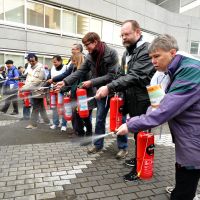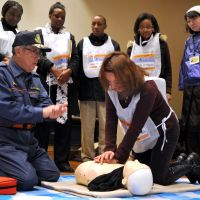For newcomers to Japan, especially those who come from countries that don't experience frequent earthquakes, preparing for natural disasters like the megaquake and tsunami that hit the Tohoku region on March 11, 2011, may not come so easily.
"In a country where we have so many natural disasters, such as earthquakes, the Japanese have taken part in many, many disaster drills since childhood — particularly at school and the workplace," said Kei Higuchi, director in charge of citizen activities at the Tokyo Metropolitan Government's Bureau of Citizens and Cultural Affairs.
"A disaster prevention drill is still something quite unfamiliar for new foreign residents to Tokyo," she said, adding that when communities hold disaster drills, not many foreigners take part, probably because information about such events is not made clear or widely disseminated.
The annual disaster drill for foreign residents that was organized by the metropolitan government on Jan. 23 at the Edo-Tokyo Museum was aimed at offering information and raising participants' awareness about disaster response efforts.
The metropolitan government has held the annual drill since 2006 and has introduced new features since the March 11 disasters. About 350 people took part this year, including foreign residents and volunteer workers, according to organizers.
The drill offers different kinds of demonstrations and activities that allow the participants to practice emergency first aid, experience an earthquake simulator and are learn how to properly handle a fire extinguisher.
For the first time this year, the participants experienced what it is like to stay in an evacuation shelter — living in rooms with cardboard partitions and making plates and simple slippers out of newspaper.
"We wanted to offer firsthand experience to participants on what it is like when a disaster actually hits," Higuchi said.
In addition to urging foreigners to take part in the annual drill, the metropolitan government plans to encourage municipalities in the capital to hold disaster drills during local festivals so "people can have fun while learning about how to react to disasters," Higuchi added.
"We decided that if the foreigners don't attend the disaster drills held by municipalities, why not hold drills at local matsuri festivals, where lots of people — including many foreigners — gather," she said
Marleen Maat, 27, from the Netherlands, who arrived in Japan five months ago and attended a disaster response drill for the first time, said that in her home country, where earthquakes "don't exist," people are not aware of the possible dangers, and don't know how to react to such disasters. "I've seen a lot on the news about the (March 11) disaster and its consequences and felt (compassion for) the victims. It's important to be able to protect yourself and your family if such a disaster ever occurs," she said.
While a lot of the participants said they have lived in Japan for only a short period, others experienced the March 11 earthquakes and felt it is important that everyone is well-prepared.
Romanian Adrian Cristea, 33, said the March 11 experience was "scary and strange." Afterward, he said he felt the need to gather as much information as possible to better prepare for living in a country that experiences so many quakes.
Simona Stinga, the second secretary at the Romanian Embassy, agreed. She said drills are a good way to prepare for emergencies. She said even when scared, you will still remember some of what you have learned, thus, increasing the chances of saving yourself and others around you.
Higuchi said they discovered after the March 11 quake and tsunami that much-needed and accurate information was not distributed in an efficient manner to foreign residents during and after the disaster.
When the disaster hit, many foreign residents in Tokyo — particularly those who speak and read little Japanese — were said to have been at a loss as to what to do. Some who responded to local government surveys said they couldn't understand the instructions announced on trains when rail services stopped or the explanations about the disaster broadcast by Japanese news services.
Last year, a metropolitan government-commissioned panel handed out questionnaires to foreign residents in the capital, 61 international exchange groups and 20 foreigners' assistance groups in order to find out their needs and concerns after the March 11 disaster.
They discovered from the answers that those who were not fluent Japanese speakers found it difficult to understand the special earthquake-related terms used on government websites. They also found that many of the foreign residents turned to social-networking services in various languages to gather information rather than trust Japanese government Web sites.
The committee recommended that emergency information provided to foreigners be written in easy Japanese so that not only fluent Japanese speakers, but also beginners, can more easily understand it.
The metro government and some municipalities offer disaster-related information in English and a few other languages on websites and pamphlets, but to provide information in other languages is difficult due to limited resources, Higuchi said. "So providing information in easy Japanese will be very useful."
She added:"In the future, we should consider using more Twitter, Facebook, and other forms of social-networking services to distribute information correctly and swiftly in times of disaster."




















With your current subscription plan you can comment on stories. However, before writing your first comment, please create a display name in the Profile section of your subscriber account page.